Read Time: 6 Minutes Subscribe & Share
More Than A Sneeze
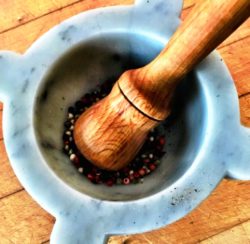 One of the many benefits of attending the Fancy Food Shows is that you get introduced to new levels of quality and variety in even the most mundane foods and seasonings. Think things like ketchup, salt or pepper — items my mind had pretty much relegated to the chart of the elements. While I fretted about the best pepper mills for the shop, it did not occur to me that one could purchase more than black, white or green pepper. That there existed variety and levels of quality governed by earth, climate and care, similar to the forces shaping wine came as a great surprise.
One of the many benefits of attending the Fancy Food Shows is that you get introduced to new levels of quality and variety in even the most mundane foods and seasonings. Think things like ketchup, salt or pepper — items my mind had pretty much relegated to the chart of the elements. While I fretted about the best pepper mills for the shop, it did not occur to me that one could purchase more than black, white or green pepper. That there existed variety and levels of quality governed by earth, climate and care, similar to the forces shaping wine came as a great surprise.
Black Gold
I vaguely remember from high school history classes that pepper was once used as currency, but not until I went to the source of all information on my screen (no more expensive encyclopedias lining our shelves) did I learn that pepper has a much richer history than I remembered. Peppercorns originally had been a most profitable crop in India, where the first descriptions date back to 2000BC. Peppercorns were an astonishing find in the nostrils of the mummified remains of Rameses II. Piper Nigrum (the official name of peppercorns) served as ransom commodity between warring states in ancient Greece. While the Greeks used pepper to spice wine and as a medicinal treatment, Romans slathered them on just about everything they ate; 75% of their documented recipes include pepper. Records show that Roman cargo ships made annual trips to India for pepper and that these voyages comprised of 120 ships! In the 5th century AD, when Imperial Rome was besieged and in danger of being sacked by Alaric and the Visigoths, around a ton of peppercorns (in addition to a vast amount of silver and gold) was demanded as payment to not destroy the city. The Romans didn’t pay up and the city went up in flames.
ancient Greece. While the Greeks used pepper to spice wine and as a medicinal treatment, Romans slathered them on just about everything they ate; 75% of their documented recipes include pepper. Records show that Roman cargo ships made annual trips to India for pepper and that these voyages comprised of 120 ships! In the 5th century AD, when Imperial Rome was besieged and in danger of being sacked by Alaric and the Visigoths, around a ton of peppercorns (in addition to a vast amount of silver and gold) was demanded as payment to not destroy the city. The Romans didn’t pay up and the city went up in flames.
The incredibly lucrative spice trade in Medieval Europe, including pepper, was domina ted by Genoa and Venice. In that era, pepper and other spices figured heavily in meals of the ruling classes. Later,dominance in the pepper trade (and other spices, like nutmeg) was heavily fought over by European countries, including Portugal and the Netherlands, along with the Ottoman Empire.(Any reading of the history of the Dutch East India Trading Company reveals how this enterprise was the benchmark of cutthroat capitalism). As a traded commodity, Piper Nigrum remained supreme until European demand for tobacco, tea, cotton and chocolate relegated its value to a lesser rank.
ted by Genoa and Venice. In that era, pepper and other spices figured heavily in meals of the ruling classes. Later,dominance in the pepper trade (and other spices, like nutmeg) was heavily fought over by European countries, including Portugal and the Netherlands, along with the Ottoman Empire.(Any reading of the history of the Dutch East India Trading Company reveals how this enterprise was the benchmark of cutthroat capitalism). As a traded commodity, Piper Nigrum remained supreme until European demand for tobacco, tea, cotton and chocolate relegated its value to a lesser rank.
A Pepper Who’s Who
Piper Nigrum varieties are basically dried fruits of a vine that, in the wild, snakes up trees in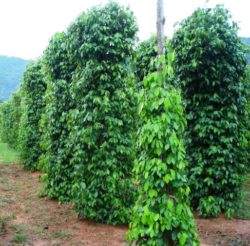 tropical areas. When planted commercially, the vines are trained on trunk-like stakes, with wood apparently superior to metal or any aggregate. Tellicherry is the pepper variety grown in the Kerala area of India. The difference between a peppercorn graded as Tellicherry rather than Malabar is simply the size. When the peppercorns are harvested from these farms, they are “garbled” or strained through screens with holes calibrated to sort for size. Peppercorns that are 4.25mm are graded “Tellicherry” and those less than that size are graded “Malabar”. Larger than 4.25mm are sometimes sold as Extra Bold Tellicherry Pepper – the measurement for these is around 4.75mm and will be priced higher than Tellicherry. The smaller Malabar peppercorns will have a higher concentration of piperine (the compound that gives pepper its bite), but the larger Tellicherry grade has more starch, which intensifies flavor and aroma. Pricing for Tellicherry grade peppercorns is higher, as there is less of this grade (sometimes only 10%) in an individual harvest.
tropical areas. When planted commercially, the vines are trained on trunk-like stakes, with wood apparently superior to metal or any aggregate. Tellicherry is the pepper variety grown in the Kerala area of India. The difference between a peppercorn graded as Tellicherry rather than Malabar is simply the size. When the peppercorns are harvested from these farms, they are “garbled” or strained through screens with holes calibrated to sort for size. Peppercorns that are 4.25mm are graded “Tellicherry” and those less than that size are graded “Malabar”. Larger than 4.25mm are sometimes sold as Extra Bold Tellicherry Pepper – the measurement for these is around 4.75mm and will be priced higher than Tellicherry. The smaller Malabar peppercorns will have a higher concentration of piperine (the compound that gives pepper its bite), but the larger Tellicherry grade has more starch, which intensifies flavor and aroma. Pricing for Tellicherry grade peppercorns is higher, as there is less of this grade (sometimes only 10%) in an individual harvest.
Lampong peppercorns are grown in southern Sumatra in Indonesia. They are smaller than those described above from Kerala in India. Lampong has a sharp peppery flavor that’s actually somewhat citrusy. It probably was exported as a crop from Indian trades to Indonesia over 2000 years ago. Lampong is the most popular pepper in the UK, and much of its harvest is exported to the US.
Sarawak peppercorns come from Borneo in Malaysia and again are smaller than Tellicherry. Sarawak is often harvested and treated in a water bath to create white peppercorns. But left to shrivel and dry as black pepper, they offer a slight fruity aroma and flavor along with the piperine bite. Chefs often use Sarawak in desserts. Personally, I find Sarawak pepper lighter in pepperiness, and it is my favorite for making Steak Au Poivre – recipe in link
is often harvested and treated in a water bath to create white peppercorns. But left to shrivel and dry as black pepper, they offer a slight fruity aroma and flavor along with the piperine bite. Chefs often use Sarawak in desserts. Personally, I find Sarawak pepper lighter in pepperiness, and it is my favorite for making Steak Au Poivre – recipe in link
White pepper is a cook’s choice for milder flavor and also as a less intrusive appearance in pale sauces, vegetables and fish. Muntok pepper comes from the island of Bangka in Indonesia and is primarily harvested as a white pepper, as some of the Sarawak is. The method for removing the black shell from the Muntok peppercorn is different, according to Penzey’s, the spice business that seeks to improve the world while sharing phenomenal seasonings. Sarawak white pepper is soaked in rapidly running water, which makes it a whiter pepper. Muntok is soaked in stream water and is more cream colored and has a milder flavor than Sarawak.
Another white pepper has hit the market, which is considered by some to be even more fragrant and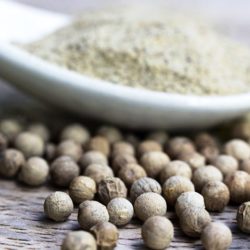 powerful in taste – Penja White pepper hails from Cameroon in West Africa. Its particular musky taste and minty aroma come from the volcanic soil of the area. And Brazil has long offered yet another distinguished white pepper – Brazilian Paper White. We used to carry it in the shop and then could not find a source in the US. Bright white, with almost a citrusy pepper flavor, this pepper variety is grown in the Amazon and, like the pepper from Cameroon, its flavors and aromas are different from those from Indonesia and Malaysia.
powerful in taste – Penja White pepper hails from Cameroon in West Africa. Its particular musky taste and minty aroma come from the volcanic soil of the area. And Brazil has long offered yet another distinguished white pepper – Brazilian Paper White. We used to carry it in the shop and then could not find a source in the US. Bright white, with almost a citrusy pepper flavor, this pepper variety is grown in the Amazon and, like the pepper from Cameroon, its flavors and aromas are different from those from Indonesia and Malaysia.
Green peppercorns, which I like a lot, are simply unripe peppercorns that are harvested and dehydrated in the shade or pickled in vinegar to preserve their color and particular mild flavor. You’ll notice that they look a lot smoother than black peppercorns, since they are not exposed to the sun. Dried, their aroma and flavor will not be as long-lasting as that of a black peppercorn.
I have bought a bag of peppercorns from Cambodia called Kampot Red Pepper. I was surprised to 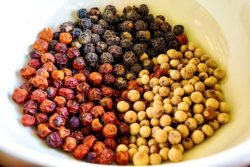 learn that piper nigrum has been cultivated in Cambodia at least since the 13th century (the first written record of its existence). According to a blog from The Spice House, Kampot Red Pepper crops were forbidden in the brutal Khmer Rouge regime in the 1970s and were reintroduced in the early part of this century. As befits a former French colony, the French government classified these reddish brown peppercorns as a product protected by the appellation d’origine contrôlée, like certain wines or cheeses, for example. In fact, the French Steak Au Poivre was often made with Kampot Pepper in the early part of the 20th century. A green piper nigrum fruit turns red before turning darker. Kampot pepper farmers pick them when they are bright red and start the drying process then. And of course the soil and microclimate of this area will give Kampot pepper its own particular aroma and flavor. I can attest to the fruitiness of this pepper, not citrusy, but rather mellow like a dried stone fruit.
learn that piper nigrum has been cultivated in Cambodia at least since the 13th century (the first written record of its existence). According to a blog from The Spice House, Kampot Red Pepper crops were forbidden in the brutal Khmer Rouge regime in the 1970s and were reintroduced in the early part of this century. As befits a former French colony, the French government classified these reddish brown peppercorns as a product protected by the appellation d’origine contrôlée, like certain wines or cheeses, for example. In fact, the French Steak Au Poivre was often made with Kampot Pepper in the early part of the 20th century. A green piper nigrum fruit turns red before turning darker. Kampot pepper farmers pick them when they are bright red and start the drying process then. And of course the soil and microclimate of this area will give Kampot pepper its own particular aroma and flavor. I can attest to the fruitiness of this pepper, not citrusy, but rather mellow like a dried stone fruit.
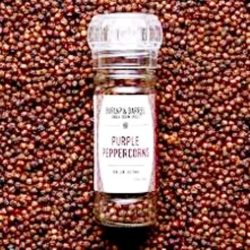 New to me, and of course now I need to try some, is the Purple Pepper from Viet Nam. Currently imported by Burlap & Barrel, the Vinh Linh variety of piper nigrum can be used like black pepper and, according to the company, “These are complex, fruity black peppercorns with an aroma like strawberries and a kick like a jalapeño. They can be used in place of black pepper in any recipe, as well as in desserts or ground over fresh cut fruit.” I have put myself on the waiting list.
New to me, and of course now I need to try some, is the Purple Pepper from Viet Nam. Currently imported by Burlap & Barrel, the Vinh Linh variety of piper nigrum can be used like black pepper and, according to the company, “These are complex, fruity black peppercorns with an aroma like strawberries and a kick like a jalapeño. They can be used in place of black pepper in any recipe, as well as in desserts or ground over fresh cut fruit.” I have put myself on the waiting list.
Shop Items Related to the Post

Kitchen Detail shares under the radar recipes, explores the art of cooking, the stories behind food, and the tools that bring it all together, while uncovering the social, political, and environmental truths that shape our culinary world.




Comments are closed here.
Follow this link to create a Kitchen Detail account so that you can leave comments!